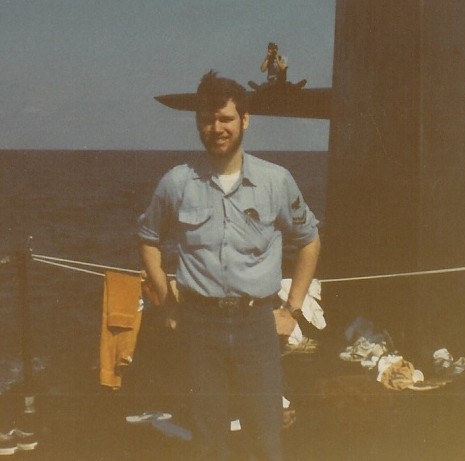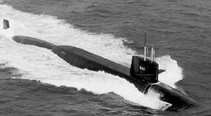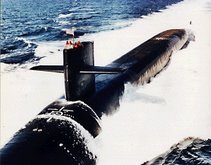Saturday, August 27, 2005
Repel Boarders "The Video Game"
Therefore, the brain learns through pattern recognition and deduction, the more embedded the pattern the stronger the memory and the quicker and easier the response. Which brings us to shipboards drills, you remember those, reactor scram, fire in the galley, torpedo hot run, WSRT, etc. Now the Navy is putting a new twist to the Repel Boarders drill - practice it with a video game.
Navy SSN 688 class submarine crews will use a custom built video game to practice anti-terrorism tactics aboard ship. The company 3Dsolve developed what is called a Force Protection Anti-Terrorism Simulation Trainer, a three-dimensional, first person view, decision making game.
National Defense Magazine has an article you can read for the details on this new twist to a common shipboard drill.
When given access 3Dsolve animation developers said they were stunned by the complexity they found inside a SSN 688 class submarine. Only 688 class Subs at the Submarine Base in New London have had scenarios created but the Navy plans on a new version to include SSBN 726 class submarines and additional port scenarios.
In 1981 I would play Asteroids at the video arcade in Virginia Beach while at Dam Neck FBM “C” school. But, I never thought someday you could play something just short of DOOM3 for your watchstation quals, times have changed!
Wednesday, August 24, 2005
Brac - Clean Sweep!!!
The Brac Commission has voted to take the Submarine Base in New London and the Portsmouth Naval Shipyard off the list of base and facility closures.

Clean Sweep (Source: US Navy via navsource.org)
Photo is from the USS Montpelier (SSN-765) preparing to moor at Naval Station Norfolk. I choose this Photo as a little poetic justice on my part. Now I wonder if any Subs will end up moving from Norfolk to Groton, only time will tell.
Sunday, August 21, 2005
We Build the Best -Submarines

General Dynamics Electric Boat (Source: US Navy Photo)
The last 688, a 688i variant, SSN 773 the USS Cheyenne was delivered to the Navy in September 1996 by NNS. Since then EB has delivered three SSN 21 Seawolf class submarines, was the lead designer of the new Virginia class submarine and delivered the SSN 774 USS Virginia in October of 2004. Newport News has not built another submarine since 1996 until the recent launch of the USS Texas SSN 775 in April of 2005. Newport News Shipbuilding also produces the best Aircraft Carriers in the world, the Nimitz class, of which nine have been built and one is currently in construction.
Therefore, who builds a better submarine General Dynamics Electric Boat or Northrop Grumman Newport News Shipbuilding? I was qualified on and rode two different boats, one built by NNS in 1965 and another built by EB in 1985. Not a fair comparison two different classes with 20 years difference in technology and design. And as I indicated before I was once a EB yardbird, so there is a built in bias here, fair warning in where I’m going with this.
Newport News has always built a quality submarine. The USS San Francisco SSN 711 built by NNS ran into a seamount at a full bell crushing it bow in January. The San Fran may not have survived if not for the quality of its construction and professionalism of the crew. But if being the “Best” means also staying on budget and delivering when contracted to then Newport News get a losing grade. NNS will not deliver the USS Texas to the Navy until May 2006 almost a year after the initial projected delivery date. Newport News Shipyard’s construction of the Texas is also an estimated 24 percent over projected cost.
Lead units are usually problematic and NNS will have had a nearly 10 year hiatus between deliveries of its last two submarines, but the Virginia class is different. In order to maintain two active submarine construction yards, production of the 10 projected Virginia class submarines is being split between EB and NNS with whole systems produced by one or the other. For example, EB will build the ships Command and Control Systems and NNS will build the Weapons Systems. Final submarine assembly will be split between each shipyard EB has completed the USS Virginia and NNS is in the process of completing the USS Texas. This is different from the 688 contracts where each yard did the bulk of its own component fabrication and construction.
Therefore, here is my argument, its not who builds thE Best submarine but who is the better shipyard at submarine construction? Both shipyards have had their share of cost overruns and problems and in the end both build a quality submarine. However, Electric Boat has an advantage in that its only business is in the design and construction of nuclear submarines for the US Navy. Newport News Shipyard builds submarines as well, but also produces Navy surface ships and has an extensive surface ship overhaul and conversion business. Additionally Electric Boat’s Quonset Point facility is dedicated to the quality fabrication of submarine pressure hull sections. In fact, a major portion of the pressure hull sections that NNS will use in the construction of Virginia Class subs will come from Electric Boat Quonset Point. Also recently the Navy has been concerned about NNS construction delays and cost overruns has asked EB to take a more active role as the lead design yard in managing Newport News Shipyard’s Virginia class submarine construction program.
With the current reduced production rate of submarines the Navy is hard pressed to keep two shipyards building submarines efficiently. Therefore, at 1.6 billion the Virginia class submarine was to be a cost saver for the Navy and far cheaper than the 2.8 – 3.0 billion Seawolf class, but the current Virginia class subs are now costing between 2.4 -2.7 billion a copy. With the current procurement rate of one submarine a year that cost could drop to just around 2.0 billion per hull if the build rate were increased to two subs per year. A side note two new subs a year would also keep our force level at it’s current state where as the one per year rate will further reduce the size of the SSN fleet as older 688s are decommissioned.
The Navy has some tough choices. In order to keep a two competitive shipyards producing submarines it must split what a single shipyard could handle easily between two yards. However, this decision comes at the expense of higher production costs. There is no economy of scale in production and smaller regional parts suppliers can no longer be supported by the effective reduction of orders. Additionally the shipyards are forced to retain higher cost engineers and trades people in order to maintain the required instructional skill sets while reducing their work force. These highly skilled shipyard workers end up back filling functions that are below their skill level or worse doing busy work thereby further driving up production costs.
Hopefully the Navy and the two remaining submarine manufactures EB and NNS can made this joint production competition/non-competition thing work. But if not and costs drive procurement rates down like the Seawolf class, from 29 hulls down to only 3 we could some day be saying that a foreign manufacture builds the “Best” submarines in the world.
Sunday, August 14, 2005
Submarines True Systems of “Transformation”
Consider the following questions:
Do submarines provide a valuable asset to the “Transformation” of the American military into a network-centric fighting force or are they just inflexible relics of the Cold War and 20th century?
What is today’s force level requirement for Submarines? Do we need the Cold War level of roughly 100 SSNs or should we let the submarine force draw down to about 30 boats?
Capt. James H. Patton Jr. USN (Ret.), president of Submarine Tactics and Technology, Inc. and former member of the Naval War College faculty addresses the above questions in a recent Newport Naval War College linked white paper “THE SUBMARINE AS A CASE STUDY IN TRANSFORMATION – Implications for Future Investment.” I recommend reading the entire paper, about five pages, but I've also provided a summary and some thoughts below.
TRANSFORMATION
Mr. Patton’s paper outlines the evolution of the submarine from 1900 to present providing examples of submarine designs adapting to unforeseen requirements. Part of that evolution:
S-Boats designed in the 1920s for coastal defense and fleet boats designed in the 1930s as battle-fleet scouts found themselves in 1942 as distantly deployed commerce raiders.
The Skipjack class, designed to provide terminal guidance for nuclear-tipped Regulus cruise missiles fired from a large fleet of Halibut-class SSGNs, never materialized because of the advent of the Polaris ballistic missile.
The Thresher/Permit-class SSNs, designed to operate in pairs while firing rocket-propelled nuclear depth charges at distant Soviet subs, never carried out that mission, due to the failure of Sesco, a secure acoustic communications system needed for information exchange and the triangulation of sonar bearings for target localization.
Escorting carrier battle groups was the justification for the high speed of the Los Angeles class in the late 1960s. Even though submarines were used in direct support of battle groups in a 1977 Pacific Fleet exercise (RimPac), and a Navy warfare publication was published in 1980 based on further experimentation in RimPacs 1978 and 1979, this mission was not routinely assigned until after the Cold War ended, when many of the class were being decommissioned.
With the above examples and others, Mr. Patton presents an argument in that “To avoid obsolescence, it was sometimes necessary for extreme variant requirements to be made technically (and tactically) during a ship’s (and crew’s) lifetime. As a result it can be safely said that no U.S. submarine has ever been employed for its designed purpose, and no commanding officer ever performed that for which he was trained.” The only exception I would make is that of SSBN Fleet Ballistic Missile submarines who's purpose of nuclear deterrence has not changed since the 1960s only the targeting packages.
But then again, excess 726 Class SSBN capacity post the Cold War has resulted in four Tridents scheduled for conversion to the new Ohio Class SSGN. This will result in adapting a submarine platform from its initial design of nuclear deterrence to one of an Information Systems Research (ISR) intelligence processing node and Special Operation Forces (SOF) platform with land strike capability. A truly network-centric warfare system as Mr. Patton qualifies with using the Giant Shadow and Silent Hammer counterterrorism exercises as examples.

USS Virginia (Source: US Navy)
Another point made in the white paper is this:
“It should also be clear, to those who think deeply about such matters, that the SSGN program is far more than just a way to extend the operational viability of declining SSBNs; it is a pilot program to investigate just what the Virginia class should become when it has fully evolved in ten years.”
Essentially the Ohio SSGN program is a proving ground for technologies and tactics that well evolve and be incorporated into the new Virginia class submarines.
FORCE LEVEL
The latter part of the Mr Patton's paper briefly addresses the number of submarines we will require for our furture submarine force "Force-Level" with this.
However, with the world situation becoming increasingly unstable, there are more than one or two places where a credible, actual, or virtual U.S. presence must be claimed or maintained. Therefore, to sustain persistently unseen assets around the world, there is a force-level number that must be maintained. This number is significantly more than thirty, the level resulting from a one-per-year build rate of thirty three-year-design-life hulls, when operating tempos, maintenance, and transits are factored in. All post–Cold War submarine force level studies by several agencies indicate an enduring need for numbers of SSNs far in excess of what can be sustained by a one-per-year build rate.
I think what unstable areas Mr. Patton alludes to is obviously the Middle East and Western Pacific. But without long forward deployments a SSN force of 30 hulls, with some in the shipyard some deployed for carrier taskforce ASW protection and some in port, the Navy would be hard pressed to “sustain persistently unseen assets around the world”.
It is stated in the paper that "SSN taskings by fleet and national commanders have essentially doubled since the end of the Cold War" even though the force level of SSNs has dropped from 100 to roughly 50 today. The predicted affect is: “Because of this submarine shortage, existing ships must now transit at much higher sustained speeds than originally planned, which threatens the life span of their reactors.” If this is true then SSNs would be heading to the shipyard sooner for refueling thereby putting addition pressure on our existing submarine assets.
Conclusion
To me all the above (Submarine systems adaptability and increased force requirements and tasking) seems to run counter to the current DOD and Navy decisions with regards to the New London Sub Base being on the Brac list and the reduced build rate for the Virginia class Subs. My concern is that the powers that be (budgetary and political) may indeed hurt Submarine Force and lessen this country’s ability to defend itself.
Thursday, August 11, 2005
Film of the Shot of the Day

Operation Crossroads Baker Shot (Source: DOE)
I ran across some film of the Operation Crossroads Baker shot (National Geographic HERE or the DOE HERE) that resulted in the test target USS Pilotfish, moored at a depth of 168 feet and at a range of 363 yards from the point of the blast, in sinking. Only 21 of the 71 ships in the Able and Baker tests actually sank but all sustained damage. If not sunk during the tests the remaining ships were heavily contaminated with radiation and were either scuttled, sunk in gunnery exercises or scrapped.
The Baker shot was a 21-kiloton shallow water test detonated some ninety feet underwater and was the final weapon test conducted as part of the original Manhattan Project.
Monday, August 08, 2005
My Russian Watch is Broken

Hey, I thought it looked cool anyway and I needed a watch at the time. Live and learn, the watch's winding stem fell off two months ago. I've changed country and service branch since, my new watch is a Swiss Army.
Therefore, when I saw this headline "Navy team given Russian wristwatches for sub rescue" (Hat tip: TheSubReport) My first thought was, I hope they get something of better quality, followed by Vika's recommendation "Don't get it wet" which I'm thinking could also apply to the current state of the Russian Navy.
Sunday, August 07, 2005
I was Four Striper for Four Minutes Today
The restoration work is dirty so I wear steel toe work boots, old blue jeans, a tee shirt, ball cap and safety glasses. The manager of the Juliett has asked the Subvets that volunteer to wear something to add color to the tours. Some of the docents wear Russian seaman shirts and hats. I’ve been doing maintenance work so I wear a tee shirt and ball cap with silver dolphins and saying simply “US Submarine Force – Silent Service”. My real job has me at a computer all day so getting down in the bilges, so to speak, and using a wire brush and scrapper feels good (as long as its my idea) and telling a sea story to a passing inquisitive tourist is, well, sort of like blogging in person. But I digress….
I had been working for about two hours and was getting hot so I got my can of ginger ale and went topside. One of the Russian subs watch standers (employee) was busy bringing up folding chairs from below decks for a Senior Chief Sonarmen’s retirement ceremony. With only one person from the Juliett doing the setup I stepped in to assist. Because of the number of the attendees 30-40 with some elderly or in a wheelchair we decided to set things up on the pier verses the Juliett’s missile deck. Within 45 minutes, everything was setup and ready to go chairs, podium, Colors, big quarterdeck shells and sideboys complete with bosun’s pipe. OK, back below for this civilian to continue my bilge therapy session.
Not so fast, time for a quick rehearsal and they need someone to fill in and be piped aboard. So yours truly is enlisted once again, this time as a couple of COMSUB or SUBRON somethings (Squadron Twelve was one I think, sorry didn’t pay attention). Must have been a site, me looking like an A-Gang striker covered head to foot in Russian pigboat dirt, being piped aboard with sideboys and all, had a little chuckle to myself.
Ceremony looked like it went off without a hitch.
Best of luck Senior Chief and thanks for your service.
Bad Air and AS-28 Submersible Rescue
"We must complete the operation in 24 hours because the supply of air on board is not without limit," Interfax news agency quoted the deputy chief of navy staff, Vladimir Pepelyaev, as saying.
"It is believed that there is still enough air for slightly more than 24 hours," Pepelyaev added. Initial offical reports said the AS-28, itself a rescue vessel, ran into trouble when its propeller became entangled in fishing nets during a military exercise. They said it had five days' supply of air -- more than enough for any rescue mission.
However, about 1100 BST on Friday, naval spokesman Igor Dygalo said the trapped vessel had only 24 hours' worth of air left. There was no official explanation why estimates of air remaining still stood at 24 hours on Saturday morning.
This submersible was primarily submarine rescue vehicle and therefore the crew would have been trained in all aspects of submarine rescue problems, including air quality and conservation. Once the crew knew that they needed to await outside rescue that training would have kicked in and may have been what pushed the air supply to the more optimistic estimates.
If my experience with doing restoration work on the old Soviet Juliett 484 is any indication the Russians kept an ample supply of lithium hydroxide for CO2 absorption. They may also have kept chlorite candles chemically similar to what is in an OBA for emergency O2 generation on board their submarines. It would be reasonable to think that this practice would include a submarine rescue submersible if not for its own use then to supplement a submarine on the bottom. Any submarine rescue vehicle would require multiple trips to a stricken submarine to effect a complete crew rescue.
As far as the political air is concerned, Putin and some Russian admirals can get some sleep tonight. It would have been a political crisis similar to that of the Kursk if things had come out differently, for the sake of the AS-28 crew, thank god and the Brits ROV team it didn't.
Friday, August 05, 2005
Been on watch - since Wed.
Sorry about no updates here but it's been chicken nuggets, popsicles and tubbies for three days. Makes for a bad blogging schedule.
Monday, August 01, 2005
Microsoft has a Navy now??
Imagine yourself cruising the high seas in a lavish, super-secret ocean-faring vessel complete with a remote controlled undersea rover, a 12-man submersible and a personal crew of 60, including several former Navy Seals and a recording studio.
First off I didn't know Navy Seals could sing, unless they were really drunk, nevermind be good enough to record!!! Paul Allen's 416-foot boat named Octopus has some other nice warship like features including:
- Garage with a 4x4 vehicle (maybe a Hummer, up-armored of course)
- Transport craft to take the 4X4 to the beach (amphibious I'm guessing)
- Two helicopter pads (no waiting for the flight back to headquarters)
- Under hull docked 12 man submersible (stealth is key for the super rich)
- Staff of former Navy Seals (for the south asian software pirates I presume)
Not to be outdone Larry Ellison CEO of Oracle has a larger 452-foot superyacht named Rising Sun also in construction.
I guess this is what you buy when the money flows like water into your bank account. Not to complain or anything but, I'd be happy with just one of their old leaky sub accounts and a used Boston Whaler......








